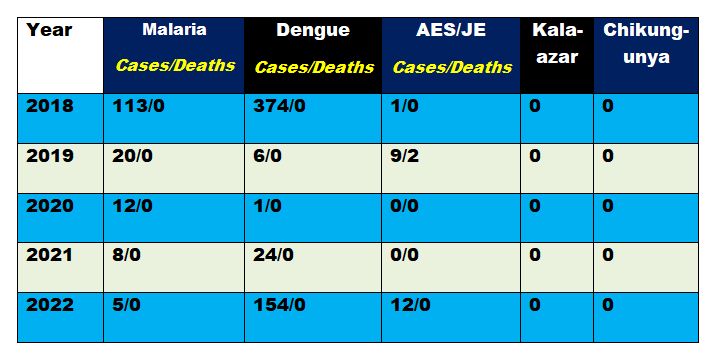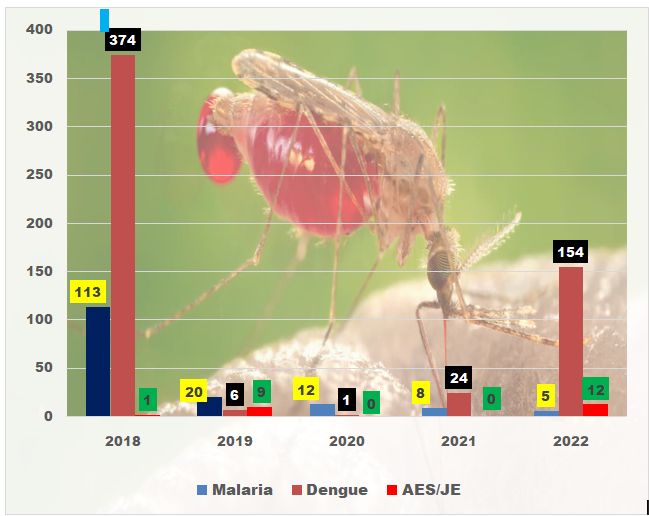
Morung Express News
Dimapur | April 4
The State of Nagaland is one of the top contenders in the race towards malaria elimination in the North-East region but Non-Communicable Diseases (NCD) are becoming the greatest health challenge, informed an official report.
Malaria is endemic in all districts of Nagaland but since 2018, cases have fallen drastically and the endemicity has reduced, informed the Annual Administrative Report 2022-23 of the Nagaland Department of Health and Family Welfare (DoHFW).
Accordingly, in 2022, no malaria cases were reported from 7 districts - Longleng, Mokokchung, Wokha, Tuensang, Mon, Kiphire and Zunheboto, while there were just 5 cases across the State, the report said.
The department overview on prevalence of Vector Borne Disease in Nagaland informed that while the State reported 133 malaria cases in 2018, it reduced to 20 in 2019 and further to 12 in 2020.
In 2021 and 2022, there were only 8 and 5 cases respectively.
As per the DoHFW, the National Vector Borne Disease Control Program (NVBDCP) covers six vector borne diseases - Malaria, Japanese Encephalitis, Dengue, Kala-azar, Chikangunya and Filariasis.
Except for dengue, all other diseases are more or less eradicated with no cases of Kala-azar, Chikangunya & Filariasis since 2018.
However, after reporting zero cases in 2020 and 2021, there were 12 cases of Acute Encephalitis Syndrome (AES)/Japanese Encephalitis (JE) in 2022.
Likewise, dengue cases surged from 24 in 2021 to 154 in 2022.
To make the goal of malaria-free status achievable, sustained efforts by the department and continued use of correct interventions in the right time, the DohFW noted.
The report also informed that there were no reports of deaths from vector borne disease in the State from 2018 to 2022, except two fatalities due to AES/JE in 2019.
NCDs challenges
Despite the notable achievement in combating vector borne disease, the DoHFW observed with concerns in the report regarding the rise in NCDS in Nagaland.
Overview of Vector Borne Disease Prevalence in Nagaland
 Source: Annual Administrative Report 2022-23, Department of Health and Family Welfare, Government of Nagaland
Source: Annual Administrative Report 2022-23, Department of Health and Family Welfare, Government of Nagaland
“NCDs are the greatest health challenge and the leading cause of illness, disability and death in Nagaland,” the report bluntly stated.
According the World Health Organisation (WHO), also known as chronic diseases, the NCDs tend to be of long duration and are the result of a combination of genetic, physiological, environmental and behavioural factors.
The main types of NCD are cardiovascular diseases (CVDs) such as heart attacks and stroke, cancers, chronic respiratory diseases (such as chronic obstructive pulmonary disease and asthma) and diabetes.
On its part, the DoHFW report attributed the high prevalence of behavioural risk factors as the major cause of increase in prevalence of NCDs in Nagaland. As per the WHO, modifiable behaviours, such as tobacco use, physical inactivity, unhealthy diet and the harmful use of alcohol, all increase the risk of NCDs.
Meanwhile, citing a 2017 study, the DoHFW stated that there were 5% prevalence of diabetes in Nagaland while it was 38% for hypertension.
The data presented by the DoHFW regarding opportunistic and population-based screening undertaken in the recent past affirmed its concern. The former occurs when a person asks health professional for a check or test or vice versa, while the latter is offered systematically to all individuals in the defined target group, among others.
As per the opportunistic screening of NCDs clinics from 11 districts from April-December 2022, out of 2,33,037 patients attending the clinic, 5337 or 2.29% were found to be diabetic.
Again, 15,118 or 6.48% of them were diagnosed with hypertension and while there were 579 cases of CVDs and 171 cases of cancer. Counselling health promotion and prevention of NCDs were given to 32,419 individuals during the same period.
The data is more concerning in the case of population-based screening from April 2022 to February 2023.
According to the DoHFW data, out of 31,700 screening from enrolment of 1,05,100, a total of 9,186 were diagnosed with hypertension indicating a 28.97.
Further, a total of 3,179 persons or 12.22% were diagnosed as diabetic out of 26,012 screened. Treatments for diabetes and hypertension respectively stood at 8,829 and 1,411.
The result was much better in the case of cancer, with just 44 cases (oral) out of 2,7274 screened and nil diagnoses for breast and cervical cancer, as per the data.
Vector Borne Disease Prevalence in Nagaland*

*No cases of other vector-borne diseases such as Chikungunya and Kala-azar during period from 2018-2022
Source: Annual Administrative Report 2022-23, Department of Health and Family Welfare, Government of Nagaland
Preventing NCDs
At present, there is one state NCD cell, 11 District NCD clinics and 15 CHC NCD clinics. Approval is granted for 5 more CHC NCDs clinics and there is proposal for two more in financial year 2023-24, it added.
The DoHFW report further highlighted various activities it is undertaking to meet the challenges on NCDs including screenings, management of common NCDs, counselling, physiotherapy, health promotion for behavioural change communication.
All the districts (11 districts) are covered under Population Based screening, whereby enabling of intensive population-based screening in campaign mode for early detection of NCDs and the associated awareness generation, it added.






